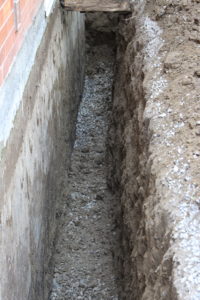13 Jun Exterior vs Interior Waterproofing
Exterior vs Interior Waterproofing
In this article, we will discuss the differences between exterior and interior waterproofing. To find the best method of waterproofing for your situation, we determine the source of moisture and the severity of a leak.
What is Exterior Waterproofing?
Exterior Waterproofing involves excavating and exposing the foundation wall. This means it requires the removal of landscaping and paved surfaces, that are within 3 feet of the foundation. It stops all water from coming into contact with your foundation walls, while directing the water to the weeping tile. Once the exterior wall is inspected for cracks, it then gets excavated. The walls then get sealed with a waterproofing membrane and a new drainage (weeping tile) which is placed on the side of the footing. This ensures that any water is stopped from entering the home while

Exterior Waterproofing
also protecting your property from frost and foundation erosion preventing future leaks and damage. This method of water proofing also allows for cracks and large gaps to be repaired.
The main advantages of exterior waterproofing are:
- Internal space is not disrupted
- Barely any preparation is required for external waterproofing, except anything you might need to move
- The new drainage system (weeping tile) drains out next to your house relieving the water pressure against foundation.
- Ensures your foundation stays dry during rain and floods.
What is Interior Waterproofing?
Interior Waterproofing also known as “water management” is a method that is sourced through an already addressed problem as the water is already through the foundation. Interior Waterproofing continues to allow water to enter through the wall, meaning that your property won’t be protected from frost or erosion. This method will use a weeping tile system to divert water away from the basement.

Interior Waterproofing
The main advantages of interior waterproofing are:
- Exterior space is not disturbed
- More economical and cost less to do
- installed all year around, even when the ground is frozen.
- Protects the home from outside issues; such as soil conditions or tree roots growing into the drainage system.
- Hydrostatic pressure is relieved.
- No need to remove finished walls of your basement to stop the leakage.
Want more information on how to decide which method would work best for you? The basement waterproofing specialists at ACCL Waterproofing know how to repair your basement and foundation walls and keep moisture out of your basement. They would be pleased to develop a guaranteed solution to keep your basement dry





No Comments